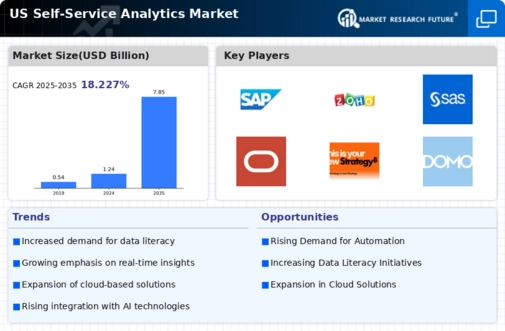Expansion of Data Sources and Types
The self service-analytics market is being propelled by the expansion of data sources and types available for analysis. In the US, organizations are increasingly leveraging diverse data sets, including structured, unstructured, and semi-structured data, to gain comprehensive insights. This proliferation of data sources necessitates advanced self service-analytics tools that can handle various data formats and provide meaningful analysis. As businesses strive to harness the full potential of their data, the self service-analytics market is expected to grow, driven by the need for versatile and robust analytics solutions that can accommodate a wide range of data types.
Rise of Business Intelligence Tools
The self service-analytics market is significantly influenced by the rise of business intelligence (BI) tools that enable users to analyze data without extensive technical expertise. In the US, the BI market has been projected to grow at a CAGR of around 10% over the next few years, indicating a robust appetite for self service-analytics solutions. These tools allow users to create reports, dashboards, and visualizations independently, thereby reducing reliance on IT departments. This democratization of data access is reshaping the self service-analytics market, as organizations seek to equip their workforce with the necessary tools to derive insights and make informed decisions.
Increased Focus on Real-Time Analytics
The self service-analytics market is witnessing a shift towards real-time analytics, driven by the need for immediate insights in fast-paced business environments. In the US, companies are increasingly adopting solutions that provide real-time data processing capabilities, allowing them to respond swiftly to market changes. This trend is reflected in the growing investment in technologies that support real-time data integration and analysis. As organizations prioritize agility and responsiveness, the self service-analytics market is likely to benefit from the demand for tools that facilitate real-time decision making and enhance operational performance.
Emphasis on User Experience and Accessibility
The self service-analytics market is evolving with a strong emphasis on user experience and accessibility. In the US, organizations are recognizing that intuitive interfaces and user-friendly designs are crucial for encouraging widespread adoption of analytics tools. As a result, many vendors are investing in enhancing the usability of their self service-analytics solutions. This focus on user experience is likely to drive market growth, as businesses seek to empower employees at all levels to engage with data effectively. By prioritizing accessibility, the self service-analytics market is positioned to attract a broader audience, ultimately fostering a data-driven culture within organizations.
Growing Demand for Data-Driven Decision Making
The self service-analytics market is experiencing a notable surge in demand as organizations increasingly recognize the value of data-driven decision making. This trend is particularly pronounced in the US, where businesses are striving to enhance operational efficiency and gain competitive advantages. According to recent estimates, approximately 70% of organizations in the US are prioritizing data analytics initiatives, which underscores the critical role of self service-analytics tools in facilitating timely insights. As companies seek to empower employees with analytical capabilities, the self service-analytics market is likely to expand, driven by the need for accessible and user-friendly data analysis solutions.

























Leave a Comment